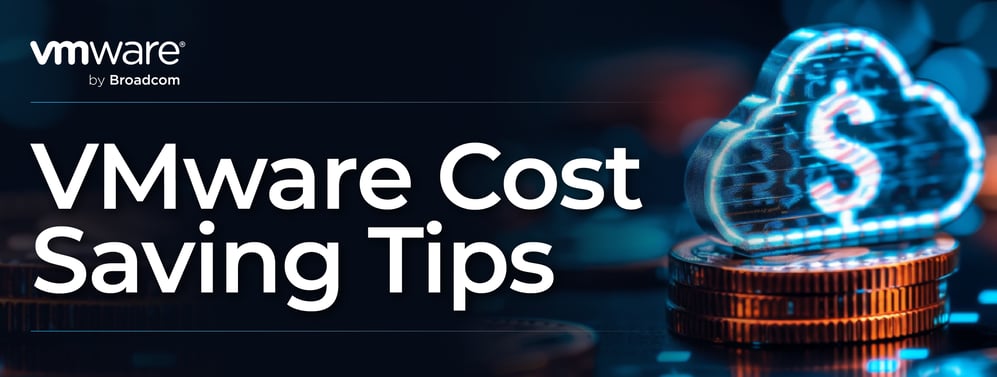VMware Cost Saving Tips
Posted by Josh Moss, xByte Solutions Architect on May 06, 2024

In today's rapidly evolving technological landscape, businesses are constantly seeking ways to streamline operations and reduce expenses without compromising on performance or reliability.
Among the myriad of hypervisor options, VMware has stood out as a cornerstone of modern infrastructure on premise, at the edge, and in the cloud for many years. However, the recent acquisition of VMware by Broadcom has prompted many organizations to reevaluate current and future infrastructure planning due to rising costs.
In this blog we will cover a few optimization and cost saving recommendations that organizations can consider and implement in their own environment and a customer case study on infrastructure optimization for VMware. If you haven’t already reviewed the VMware licensing structure changes, we recommend watching this video to become more familiar with the vSphere and vSAN licensing landscape today.
Section 1: Infrastructure Analysis & Optimization
Before you can begin optimizing your VMware environment to better fit within the current licensing structure, you need to identify two key pieces of information.
- What do I have inventory wise in my VMware environment? How many CPU sockets, CPU cores per socket, GB of RAM, and so forth?
- Of my available resources, how much am I really using?
To easily and quickly find the answers to these questions, we have one simple solution: Live Optics. In short, Live Optics is a Dell tool that not only helps you gather key performance metrics of your physical and virtual environment, but also provides a detailed inventory report of what your hardware contains. Live Optics is a free tool that costs you nothing to run! If you’re interested in running Live Optics and scheduling a free review with our team, click here.
Once you have a solid understanding of what hardware you have and how much is being utilized, we can look at a couple of potential optimizations.

Reduction of CPU cores and/or sockets
- Depending on your overall CPU utilization within your VMware environment, you can potentially reduce the number of nodes. In doing so, you reduce the overall number of cores that must be licensed.
- One big change in VMware vSphere Standard (VVS), VMware vSphere Foundation (VVF), and VMware vSphere Foundation (VCF) is the minimum of 16 licensed cores per socket. For organizations that have servers with sockets containing less than 16 cores, you’re paying for more than what you have. Here’s a few examples of what that looks like:
- Single 8 core server = 16 core licenses purchase required
- Single 12 core server = 16 core licenses purchase required
- Dual 8 core server = 32 core licenses purchase required
As you can see, you may have an opportunity to optimize your license costs by going from more processors with less cores to larger core, single socket, configurations. Of course, there are implications with socket reduction such as loss of PCIe and DIMM slots, but our certified solutions architects can help you navigate this process and determine a solution that meets your environmental and budgetary needs.
On the other hand, you may have oversized servers since the old VMware perpetual socket licenses covered up to 32 cores each. Not every organization requires so many CPU cores. If you do not need that many cores, you could potentially replace the 32 core processors with smaller 16-24 core processors to match the environment's needs and save on licensing expenses at the same time.

Memory Upgrades and Augmentations
When you begin removing nodes or altering the number of sockets, one of the biggest implications is going to be server memory. You must ensure proper amounts of RAM required for your workloads, proper channel population, and RDIMM or LRDIMM compatibility. Removing nodes and maintaining the required amount of memory in a cluster may require you to augment existing nodes with memory upgrades. Lucky for you, xByte Technologies keeps a large stock of memory available for PowerEdge servers and can help guide you throughout the process to ensure a smooth transition.

VSAN Storage
For organizations that are utilizing vSAN storage today, or those that will be looking to use vSAN storage in the future, properly sizing the amount of available vSAN storage is imperative. The two VMware licensing plans that support vSAN are the following with the details listed below each:
VMware vSphere Foundation (VVF)
- Each 1x core license has complimentary 100 GiB
- If vSAN capacity needs exceed the cumulative complimentary capacity, you must purchase vSAN per TiB add-ons*
- When you bundle VVF and vSAN per TiB add-ons, the complimentary 100 GiB per core goes away and is no longer factored in.
VMware vSphere Foundation (VCF)
- Each 1x core license includes 1 TiB vSAN Capacity Storage
- vSAN per TiB add-ons for storage needs that exceed the included 1 TiB per core
NOTE: For vSAN customers using OSA (Original Storage Architecture) you do not need to account for cache disk size, just over storage capacity claimed by vSAN. This VMware KB provides an automated way to calculate VVF and VCF CPU core and vSAN licensing requirements.
One of the greatest features of VMware vSAN is the ability to scale up or scale out at any time. You can start with what you need storage and compute wise on day one, then add disks or entire nodes as needed in the future. When it comes to optimizing costs related to vSAN storage, we’d recommend beginning with what is required from a capacity standpoint to minimize licensing costs. Then, as you require more storage in the future, you can expand licensing to match growing storage needs.
Section 2: VMware Case Study

One of our customers recently came to us with the goal of reducing their VMware licensing renewal costs. The cluster consisted of six PowerEdge Servers each with:
- Each 1x core license includes 1 TiB vSAN Capacity Storage
- vSAN per TiB add-ons for storage needs that exceed the included 1 TiB per core
- Dual 16 Core Processors
- 1 TB RAM
- Same dual 16 Core Processors
- 1.5 TB RAM each
The customer's goal was to reduce their licensing cost as much as possible. After taking inventory of the customers environment and comparing it to their actual utilization, we were able to guide them through the reduction of two nodes from their cluster and memory upgrades on the remaining four nodes:
This transition did require a complete swap from smaller RDIMMs to larger LRDIMMs, however the customer was able to realize an initial 33% VMware licensing cost savings and an eventual positive return on investment for the memory upgrades over the lifetime of the servers.
At xByte, we hear concerns from VMware customers on a daily basis. We have certified experts on staff that can help you evaluate your current environment and see what can be done to optimize your VMware licensing expenses. Contact your dedicated xByte Account Manager or email [email protected] to schedule a meeting with one of our experts!
